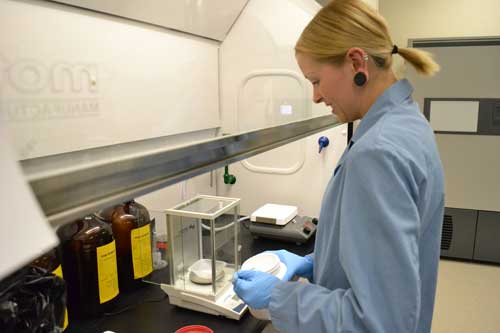The Canadian Centre for Behavioural Neuroscience (CCBN) has undergone some major renovations in the past few months to improve the space where world-renowned research is being conducted.
The former in situ lab at the CCBN was quickly outgrowing the needs of the expanding Polaris Brain Dynamics Research Group at the University of Lethbridge. But thanks to funding from the Canada Foundation for Innovation, a new, larger lab and animal facility – an addition of 224-square metres – has been built to better suit researchers' needs.
The new lab is a modern space with the capacity to operate multiple workstations simultaneously. Previously, researchers would have to travel from room to room to gather supplies or use a particular piece of equipment, while changing lab coats and other protective gear between rooms.

Research technicians Valérie Lapointe and Aubrey Demchuk, who help to manage the lab and assist undergraduate and graduate students, post-doctoral fellows and principal investigators with their research, say the extra space has greatly improved their working conditions.
"The room where we were doing the experiments before was very tiny. We could only work with a few people at a time, and we'd kind of walk on one another," says Lapointe, who was part of the planning and design process for the new in situ lab. "It's nice that it is bigger and that everything is here in one room."
"We're really lucky to have as much space as we have now," says Demchuk.
Dr. Bruce McNaughton, Alberta Heritage Foundation for Medical Research (AHFMR) Polaris Research Chair, says many projects were put on hold until the new lab could be built.
"We now have an outstanding neural imaging facility for both live animal imaging and quantitative microscopy. As well as an integrated center for neuroscience data analysis, with workstations connected to our parallel supercomputing facility," he says. "These new facilities will enable a big increase in lab productivity and the output of high quality basic and preclinical neuroscience."
When it came to building the lab, most of the work was in the details, says project manager Brad Robinson.
"You can see, the counters are just full of lab equipment, so I had to do elevation views of each wall and know where each piece of equipment was going, where the plug was going, where the data plug was going, where the light switches were going, where the thermostats were going and so on. I had to know where everything needed to be logistically to create a well-organized, functioning lab," he says.
The rodent research facility at CCBN also received an overhaul. It now features 45 animal experiment/research rooms, six surgery suites, a quarantine room, seven animal housing rooms, an MRI room, an MPE (multiphoton electron) microscope room and an optical imaging room equipped with specialized LED surgical lights and Nederman gas extractor arms that can be placed almost anywhere near a surgery table to exhaust vapours.
Making renovations to the CCBN's animal facility wasn't without its challenges. Construction work can severely impact research. Simply drilling a hole into the drywall contaminates a room. The preparation and planning to shut down an area of the facility can take longer than the actual construction work, but if the proper precautions are not taken, the entire animal facility could be contaminated and thousands of hours of research work would be lost.
"Shutting down parts of the building to tie the new infrastructure into the existing infrastructure was a real team effort," says Robinson.
This story first appeared in the September 2012 issue of the Legend. For a look at the full issue in a flipbook format, follow this link.
